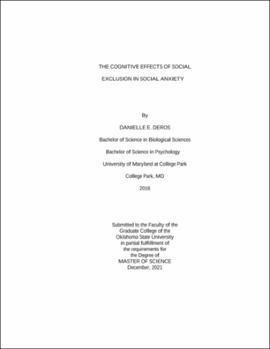| dc.description.abstract | Social anxiety (SA) is characterized by persistent and intense fears of situations that provide the opportunity for social evaluation. Moreover, SA is often associated with core interpersonal (e.g., overt social skills, differential processing of socially-salient cues) and intrapersonal (e.g., biased attention and cognitions toward others and of oneself within social settings) impairments that present across a variety of social contexts. In particular, those with SA tend to demonstrate differences in attentional engagement and disengagement with socially-salient information such as negative facial expressions relative to those without SA. Moreover, social exclusion may serve as a social context in which such fears associated with core features of SA may be initiated and exacerbated. As a result, understanding sensitivity to different social contexts in which these fears and biases may present may clarify maintenance factors and adverse outcomes associated with SA. However, there currently exists a paucity of research regarding the nuanced impacts of different forms of social exclusion on impairments associated with SA. The present work aims to address these gaps at the intersections of attention, socio-emotional cue processing, and social exclusion in an effort to expand upon literature regarding mechanisms maintaining SA concerns. Using a mixed factorial 2 SA group (Low, High) by 2 Exclusion Type (Ostracism, Rejection) by 3 Time (Baseline, Post-Inclusion, Post-Exclusion) design, participants engaged online in a series of modified dot-probe tasks at baseline and following inclusion and exclusion versions of either Cyberball or an adapted written feedback-based rejection task. Primary results revealed a statistically significant main effect of time such that participants, on average, responded more slowly on trials within the modified dot probe task relative to those at the post-inclusion or post-exclusion versions of the same tasks. These findings may correspond to practice effects, and are inconsistent with broader literature. Implications, limitations, and future directions are discussed. | |
